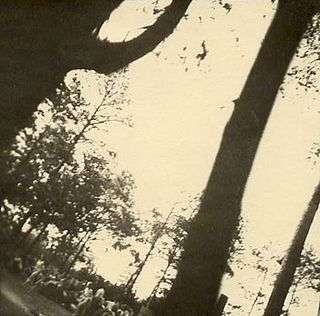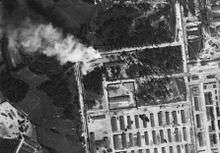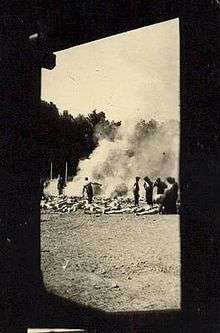Sonderkommando photographs

The Sonderkommando photographs are four photographs taken secretly in August 1944 inside the Auschwitz concentration camp in Nazi-occupied Poland.[1] The images were taken by Alberto Errera, a Greek inmate in Auschwitz II-Birkenau, the extermination camp within the Auschwitz complex, and along with a few photographs in the Auschwitz Album are the only ones known to exist of events around the gas chambers.[2]
The photographer was a member of the Sonderkommando, inmates forced to work in and around the gas chambers. He took two shots from inside one of the gas chambers and two outside, shooting from the hip, unable to aim the camera with any precision. The Polish resistance smuggled the film out of the camp in a toothpaste tube.[3]
The photographs were numbered 280–283 by the Auschwitz-Birkenau State Museum.[4] Nos. 280 and 281 show the cremation of corpses in a fire pit, shot through the black frame of the gas chamber's doorway or window. No. 283 is an image of trees, the result of the photographer aiming too high. No. 282 shows a group of naked women just before they entered the gas chamber.[5]
Sonderkommando

The Sonderkommando ("special commandos") in Auschwitz were mostly Jewish inmates, and at one point a few Russian prisoners-of-war, who were forced to work in the crematoria. The crematoria contained the gas chambers and furnaces. In the summer of 1944 the camp had four crematoria in operation (II–V), a bunker with extra gas chambers (housed in a thatched brick building known as the "little white house"), and up to 1,000 Sonderkommando.[6]
After inmates had been selected as unfit for work by the SS, the Sonderkommando usually took them to the undressing room (Entkleidungskammer), then walked them to the gas chamber, telling them they were being taken to the bathing and disinfection room.[7] To avoid panic, inmates were given a numbered hook for their belongings in the undressing room to make them believe they would be returning.[8]
Afterwards the Sonderkommando moved the bodies out of the gas chamber, removed gold fillings, false teeth, hair, jewellery and spectacles, and disposed of the corpses, at first in mass graves, later in furnaces and fire pits. They then cleaned the gas chamber for the next arrivals.[9]
Taking the photographs


The photographer is usually named only as Alex, a Jewish inmate from Greece. Several sources have identified him as Alberto Errera, a Greek naval officer who was shot and killed after striking an SS officer.[10]
Other members of the Sonderkommando in the camp's crematorium V – Alter Fajnzylberg (also known as Stanislaw Jankowski), brothers Shlomo and Josel Dragon, and David Szmulewski – helped obtain and hide the camera, and acted as look-outs.[11]
Fajnzylberg, who had worked at crematorium V since July 1943,[12] described how the photographs came to be taken:
[S]omewhere about midway through 1944, we decided to take pictures secretly to record our work ... In order to do that, it was necessary to get a good camera and film ... From the very beginning, several prisoners from our Sonderkommando were in on my secret: Szlomo Dragon, his brother Josek Dragon, and Alex, a Greek Jew whose surname I do not remember.
On the day on which the pictures were taken ... we allocated tasks. Some of us were to guard the person taking the pictures. In other words, we were to keep a careful watch for the approach of anyone who did not know the secret, and above all for any SS men moving about in the area. At last the moment came. We all gathered at the western entrance leading from the outside to the gas-chamber of Crematorium V: we could not see any SS men in the watchtower overlooking the door from the barbed wire, nor near the place where the pictures were to be taken. Alex, the Greek Jew, quickly took out his camera, pointed it towards a heap of burning bodies, and pressed the shutter. This is why the photograph shows prisoners from the Sonderkommando working at the heap. One of the SS was standing beside them, but his back was turned towards the crematorium building. Another picture was taken from the other side of the building, where women and men were undressing among the trees. They were from a transport that was to be murdered in the gas-chamber of Crematorium V.[13]Fajnzylberg recalled that the camera looked like a German Leica.[14] Szmulewski had hidden it in a bucket, and stayed on the roof of the crematorium as a look-out while Alex shot the film.[3] Fajnzylberg stressed that, although Alex had pressed the shutter, all five men had been present and had acted together.[14] According to Szmulewski, speaking in 1987 to Jean-Claude Pressac, the four photographs were taken within 15–30 minutes of each other. The black frame of the gas chamber's doorway or window, probably doorway, is visible in photographs 280 and 281.[15]
The film was smuggled out of the camp by the Polish underground, hidden inside a tube of toothpaste by Helena Dantón, who worked in the SS canteen. A note dated 4 September 1944 and signed Stakło, written by political prisoners Józef Cyrankiewicz and Stanisław Kłodziński, was attached to the film.[3] It asked that the photographs be sent to "Tell," Teresa Łasocka-Estreicher of the underground in Kraków:[16]
Originals




When the photographs were first distributed by the Polish resistance, they were cropped to focus on the figures, with the black frames in the two fire-pit images removed. Photography historian Janina Struk writes that Teresa Łasocka-Estreicher ("Tell" in the note from the camp) asked Polish photographer Stanisław Mucha to make prints, and it is assumed that it was Mucha who decided to crop them.[18]
Some of the cropped images were published in 1945, attributed to Sonderkommando member David Szmulewski, in a report on Auschwitz-Birkenau by Polish judge Jan Sehn.[19] One was exhibited at Auschwitz in 1947, and others were published in 1958 in Warsaw in a book by Stanisław Wrzos-Glinka, Tadeusz Mazur and Jerzy Tomaszewski, 1939–1945: Cierpienie i walka narodu polskiego (published in English as 1939–1945: We Have Not Forgotten). Some of the figures had been retouched to make them clearer.[20]
Struk writes that, in 1960, Władyslaw Pytlik of the resistance movement in Brzeszcze offered testimony about his wartime experiences to the Auschwitz-Birkenau State Museum, and brought along three prints of the cropped photographs.[20] It was only in 1985, after Pytlik died and his wife donated his photographs to the museum, including the uncropped versions, that the museum realized the prints they had seen before had been cropped.[18]
Commentators have argued that the cropping offers a distorted view of events, giving the impression that the photographer was able to use his camera openly. In fact he and the rest of the group placed themselves in great danger by taking the shots; in two of them, 282 and 283, it is clear that he was not even able to look through the lens.[21] The art historian Georges Didi-Huberman argues that the cropping makes the photographs appear safe, erases the act of resistance and the phenomenology of the images, the process that "made them an event":[22]
References
- ↑ Georges Didi-Huberman, Images in Spite of All: Four Photographs from Auschwitz, University of Chicago Press, 2008; first published as Images malgré tout, Les Éditions de Minuit, 2003.
- ↑ Franziska Reiniger, "Inside the Epicenter of the Horror – Photographs of the Sonderkommando", Yad Vashem: "Among the millions of photographs that are related to Nazi death camps, only four depict the actual process of mass killing perpetrated at the gas chambers in Auschwitz-Birkenau."
- 1 2 3 Didi-Huberman 2008, p. 16.
- ↑ Dan Stone, "The Sonderkommando Photographs", Jewish Social Studies, 7(3), Spring/Summer 2001, (pp. 132–148), p. 143, n. 3.
- ↑ Didi-Huberman 2008, p. 117.
- ↑ For Sonderkommando, Danuta Czech, "The Auschwitz Prisoner Administration," in Yisrael Gutman, Michael Berenbaum (eds.), Anatomy of the Auschwitz Death Camp, Indiana University Press, 1998, p. 372; for crematoria, Franciszek Piper, "Gas Chambers and Crematoria," in Gutman and Berenbaum 1998.
- ↑ Gideon Greif, We Wept Without Tears: Testimonies of the Jewish Sonderkommando from Auschwitz, Yale University Press, 2005, pp. 12–13, 134–135.
- ↑ Piper 1998, p. 166.
- ↑ Graif 2005, pp. 5–8, 15–16, 321.
- ↑ Dan Stone, History, Memory and Mass Atrocity, Vallentine Mitchell, 2006, p. 16.For Errera's details, Greif 2005, p. 375, n. 2; Steven B. Bowman, The Agony of Greek Jews, 1940–1945, Stanford University Press, 2009, p. 95; Shlomo Venezia, Inside the Gas Chambers: Eight Months in the Sonderkommando of Auschwitz, John Wiley & Sons, 2013, p. 90ff.
- ↑ Stone 2001, p. 132.
- ↑ Jean-Claude Pressac, Auschwitz: Technique and Operation of the Gas Chambers, Beate Klarsfeld Foundation, 1989, p. 124.
- ↑ Janina Struk, Photographing the Holocaust: Interpretations of the Evidence, I. B. Tauris, 2004, p. 114.
- 1 2 Struk 2004, p. 115.
- ↑ Pressac 1989, p. 424.
- ↑ Stone 2001, p. 148, n. 48.
- ↑ Didi-Huberman 2008, pp. 16–17.
- 1 2 Struk 2004, p. 118.
- ↑ Pressac 1989, p. 422.
- 1 2 Struk 2004, p. 117.
- ↑ Reiniger (Yad Vashem).
- ↑ Didi-Huberman 2008, p. 36.
- ↑ Didi-Huberman 2008, pp. 35–36.
Further reading
| Wikimedia Commons has media related to Auschwitz resistance photos. |
- Nathan Cohen, "Diaries of the Sonderkommando," in Yisrael Gutman, Michael Berenbaum (eds.), Anatomy of the Auschwitz Death Camp, Indiana University Press, 1998, p. 522ff.
- Teresa Swilebocka (ed.), Auschwitz: A History in Photographs, Indiana University Press, 1993.